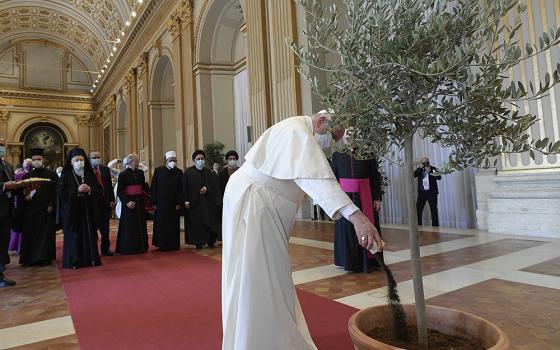Our Easter Gospel readings may leave us surprisingly disappointed. As we go to the garden to celebrate the first day of the new creation, these narratives leave us disoriented in the ambiguous land of an open tomb.
 The closest we get to Easter faith is the statement that the beloved disciple saw and believed something: The Gospel does not tell us what he believed and adds that neither he nor the others understood the scriptural teaching that Jesus "had to rise from the dead." These two Gospel fragments are almost as unsatisfactory as the original ending of Mark's Gospel, which said that the women who had seen the angels went away and said nothing to anyone because they were afraid.
The closest we get to Easter faith is the statement that the beloved disciple saw and believed something: The Gospel does not tell us what he believed and adds that neither he nor the others understood the scriptural teaching that Jesus "had to rise from the dead." These two Gospel fragments are almost as unsatisfactory as the original ending of Mark's Gospel, which said that the women who had seen the angels went away and said nothing to anyone because they were afraid.
| Easter Sunday |
| Acts 10:34a, 37-43 Psalm 118 Colossians 3:1-4 or 1 Corinthians 5:6b-8 John 20:1-9 |
Faced with these disenchanting accounts, we might look to the first two readings for Easter Sunday to save the day. From Acts, we hear the now courageous and still loquacious Peter proclaim a simple and satisfactory creed, the real point of which seems to be that faith in the Resurrection implies giving witness. Following that, Paul exhorts the Colossians about living out the implications of their baptism. These two readings at least recognize the Resurrection instead of leaving us standing with the disciples, staring into a vacant space.
Because we know that the story goes on and gets better, we ought to suspect that these Gospels were chosen to teach us something very particular about Easter faith. By bringing us up short with an unfinished story, they seem to be inviting us into an event still in process rather than a fait accompli. Through our observance of Holy Week, we walked the way of Jesus' last days and faced the apparent triumph of evil. On Friday, we listened to Jesus say, "It is finished," and heard how they disposed of his body. Now we accompany Mary and then Peter and the beloved to encounter a scene of absence seemingly worse than the one symbolized by the body of the deceased Jesus.
These Easter readings, like all Resurrection accounts, caution us against a facile faith, an assumption that the third day was a quick fix for evil. It took the disciples time to grasp the reality of Christ's resurrection both in what it meant for him and what it implied for them. We see that clearly in Paul's call to the Colossians. Reminding them that they were raised with Christ, he warns that their new status is tenuous; they have received it, but only with effort will they experience its efficacy. They don't yet live in the heavenly realm. Therefore, they must continually bring Christ's life to bear on everything that would otherwise be limited to worldly values. Peter says much the same as he explains that the experience of meeting the risen Christ necessarily implied a mission to preach his message of forgiveness.
With the stories of the open tomb, our Easter Sunday Gospel readings unexpectedly lead us to contemplate Jesus' absence. That of course leads us to Mary of Magdala's implied question: "Where is he?" The other two readings for Sunday may not offer a direct response, but they do give us clues; without telling us exactly where to find the risen Christ, they point out what happens when he has been found.
Peter says that those who know the risen Christ become apostles of forgiveness. They recognize themselves as forgiven sinners, they freely offer forgiveness, and they live giving witness to their effective conviction that the evil found in the world will never have the last word. As we celebrate Easter, the prime baptismal day, Paul reminds the Christian community that baptism confers both grace and a vocation. The grace is that of being offered Christ's perspective on the world. The vocation is to make that perspective operative in our day-to-day lives.
In reality, today's readings reveal as much as they conceal. They tell us we will never encounter the risen Lord in the realm of death. Whether that is war, tragedy, sickness or evil, all we will find there are signs, even if cryptic, that death has been overcome.
At the same time, the readings invite us to open our eyes to the unexpected signs of Christ's presence in mercy, forgiveness and a vision that goes beyond our earthly expectations. We have the next 50 days to celebrate and continue to grapple with the meaning of Easter. Our readings will continue to involve us in the ongoing find-and-hide-and-seek rhythm of understanding what it means to know the risen Lord. As we strive to decipher the signs, we may be guided by Peter and Paul's unambiguous conviction that where there is real presence, there is real change.
[Mary M. McGlone is a Sister of St. Joseph of Carondelet. She is a freelance writer and executive director of FUVIRESE USA.]

